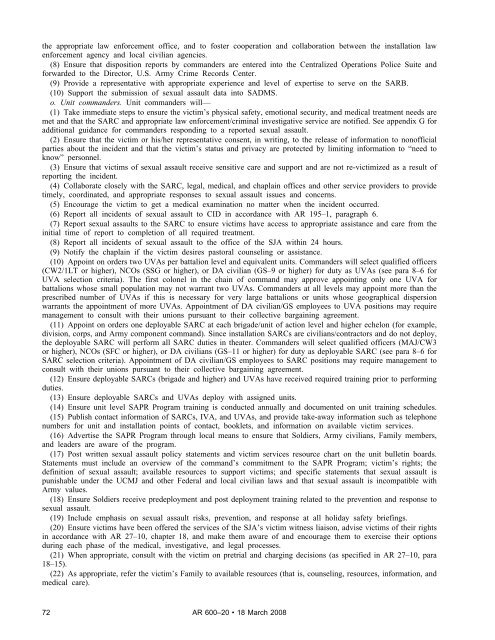AR 600-20, Army Command Policy - Army Publishing Directorate ...
AR 600-20, Army Command Policy - Army Publishing Directorate ...
AR 600-20, Army Command Policy - Army Publishing Directorate ...
Create successful ePaper yourself
Turn your PDF publications into a flip-book with our unique Google optimized e-Paper software.
the appropriate law enforcement office, and to foster cooperation and collaboration between the installation law<br />
enforcement agency and local civilian agencies.<br />
(8) Ensure that disposition reports by commanders are entered into the Centralized Operations Police Suite and<br />
forwarded to the Director, U.S. <strong>Army</strong> Crime Records Center.<br />
(9) Provide a representative with appropriate experience and level of expertise to serve on the S<strong>AR</strong>B.<br />
(10) Support the submission of sexual assault data into SADMS.<br />
o. Unit commanders. Unit commanders will—<br />
(1) Take immediate steps to ensure the victim’s physical safety, emotional security, and medical treatment needs are<br />
met and that the S<strong>AR</strong>C and appropriate law enforcement/criminal investigative service are notified. See appendix G for<br />
additional guidance for commanders responding to a reported sexual assault.<br />
(2) Ensure that the victim or his/her representative consent, in writing, to the release of information to nonofficial<br />
parties about the incident and that the victim’s status and privacy are protected by limiting information to “need to<br />
know” personnel.<br />
(3) Ensure that victims of sexual assault receive sensitive care and support and are not re-victimized as a result of<br />
reporting the incident.<br />
(4) Collaborate closely with the S<strong>AR</strong>C, legal, medical, and chaplain offices and other service providers to provide<br />
timely, coordinated, and appropriate responses to sexual assault issues and concerns.<br />
(5) Encourage the victim to get a medical examination no matter when the incident occurred.<br />
(6) Report all incidents of sexual assault to CID in accordance with <strong>AR</strong> 195–1, paragraph 6.<br />
(7) Report sexual assaults to the S<strong>AR</strong>C to ensure victims have access to appropriate assistance and care from the<br />
initial time of report to completion of all required treatment.<br />
(8) Report all incidents of sexual assault to the office of the SJA within 24 hours.<br />
(9) Notify the chaplain if the victim desires pastoral counseling or assistance.<br />
(10) Appoint on orders two UVAs per battalion level and equivalent units. <strong>Command</strong>ers will select qualified officers<br />
(CW2/1LT or higher), NCOs (SSG or higher), or DA civilian (GS–9 or higher) for duty as UVAs (see para 8–6 for<br />
UVA selection criteria). The first colonel in the chain of command may approve appointing only one UVA for<br />
battalions whose small population may not warrant two UVAs. <strong>Command</strong>ers at all levels may appoint more than the<br />
prescribed number of UVAs if this is necessary for very large battalions or units whose geographical dispersion<br />
warrants the appointment of more UVAs. Appointment of DA civilian/GS employees to UVA positions may require<br />
management to consult with their unions pursuant to their collective bargaining agreement.<br />
(11) Appoint on orders one deployable S<strong>AR</strong>C at each brigade/unit of action level and higher echelon (for example,<br />
division, corps, and <strong>Army</strong> component command). Since installation S<strong>AR</strong>Cs are civilians/contractors and do not deploy,<br />
the deployable S<strong>AR</strong>C will perform all S<strong>AR</strong>C duties in theater. <strong>Command</strong>ers will select qualified officers (MAJ/CW3<br />
or higher), NCOs (SFC or higher), or DA civilians (GS–11 or higher) for duty as deployable S<strong>AR</strong>C (see para 8–6 for<br />
S<strong>AR</strong>C selection criteria). Appointment of DA civilian/GS employees to S<strong>AR</strong>C positions may require management to<br />
consult with their unions pursuant to their collective bargaining agreement.<br />
(12) Ensure deployable S<strong>AR</strong>Cs (brigade and higher) and UVAs have received required training prior to performing<br />
duties.<br />
(13) Ensure deployable S<strong>AR</strong>Cs and UVAs deploy with assigned units.<br />
(14) Ensure unit level SAPR Program training is conducted annually and documented on unit training schedules.<br />
(15) Publish contact information of S<strong>AR</strong>Cs, IVA, and UVAs, and provide take-away information such as telephone<br />
numbers for unit and installation points of contact, booklets, and information on available victim services.<br />
(16) Advertise the SAPR Program through local means to ensure that Soldiers, <strong>Army</strong> civilians, Family members,<br />
and leaders are aware of the program.<br />
(17) Post written sexual assault policy statements and victim services resource chart on the unit bulletin boards.<br />
Statements must include an overview of the command’s commitment to the SAPR Program; victim’s rights; the<br />
definition of sexual assault; available resources to support victims; and specific statements that sexual assault is<br />
punishable under the UCMJ and other Federal and local civilian laws and that sexual assault is incompatible with<br />
<strong>Army</strong> values.<br />
(18) Ensure Soldiers receive predeployment and post deployment training related to the prevention and response to<br />
sexual assault.<br />
(19) Include emphasis on sexual assault risks, prevention, and response at all holiday safety briefings.<br />
(<strong>20</strong>) Ensure victims have been offered the services of the SJA’s victim witness liaison, advise victims of their rights<br />
in accordance with <strong>AR</strong> 27–10, chapter 18, and make them aware of and encourage them to exercise their options<br />
during each phase of the medical, investigative, and legal processes.<br />
(21) When appropriate, consult with the victim on pretrial and charging decisions (as specified in <strong>AR</strong> 27–10, para<br />
18–15).<br />
(22) As appropriate, refer the victim’s Family to available resources (that is, counseling, resources, information, and<br />
medical care).<br />
72 <strong>AR</strong> <strong>600</strong>–<strong>20</strong> 18 March <strong>20</strong>08
















